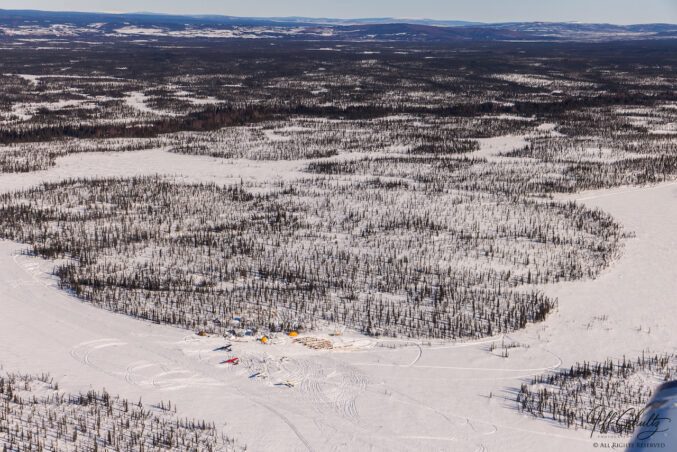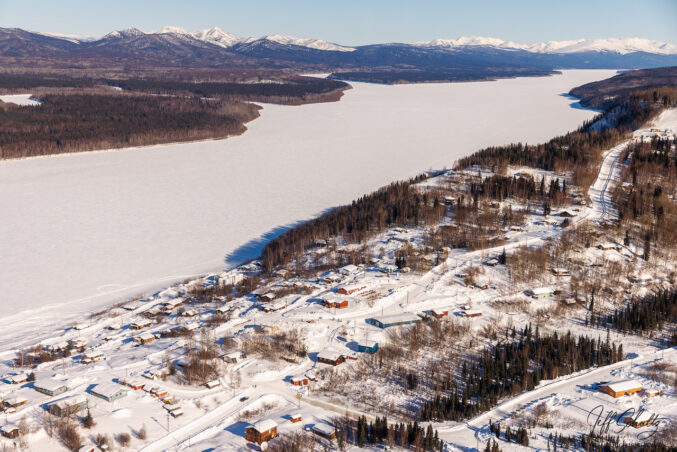
Friday March 11, 2022 during the 50th running of the Iditarod Trail Sled Dog Race.
Copyright (C) Jeff Schultz/SchultzPhoto.com ALL RIGHTS RESERVED
Ophir was a bustling place earlier in the week but just like back in the gold rush, everyone has come and gone. Back in the gold rush days, prospectors located gold along many of the creeks that flow into the Innoko River. In 1906, the miners named their town after the wealthy land of Ophir mentioned in the Old Testament of the Bible with hope of becoming wealthy themselves. In 1910 the population peaked at 122 people. In the past week that number was eclipsed by sled dogs but not my mushers, volunteers or vets.
Almost 75% of the teams have reached the Yukon River. Some have rested at Ruby and are now moving down the river in pursuit of Brent and Dallas. It appears that Brent is resting at Kaltag and Dallas is resting at Nulato. Brent can head off to Unalakleet at 10:36 while Dallas can head to Kaltag at 08:32. While Dallas comes off his 8-hour Yukon Rest 2 hours ahead of Brent, he is 46 miles behind him. There was a significant speed difference between the two mushers while traveling to their preferred resting place. Sass clipped along at 9.89 miles per hour between Nulato and Kaltag while Dallas covered the distance between Galena and Nulato at 6.22 miles an hour.

Aerila view of the village of Ruby on the Yukon River with teams resting near the community center. Friday March 11, 2022 during the 50th running of the Iditarod Trail Sled Dog Race.
Copyright (C) Jeff Schultz/SchultzPhoto.com ALL RIGHTS RESERVED
There are two former champions running in the top ten on the Yukon River right now – Dallas Seavey and Mitch Seavey. Peter Kaiser is running eleventh and Joar Leifseth Ulsom is in 16th. Jeff King is sitting in Ruby at 22nd doing his 24 hour rest. Martin Buser is resting in Ruby at 27th place. Between them they have the remarkable total of 18 championships!
It looks as if there’s some good trail on the Yukon. Check the tracker and note the speed of the mushers. Aaron Burmeister is running at 9.3 MPH, Ryan Redington 9.6, Mille Porsild 9.7, Matt Hall at 9.2, Lev Shvarts 9.2 and Hanna Lyrek at 9.3. Checking the weather at Galena, it’s clear and 7 degrees with winds out of the East. This section of trail from Ruby to Galena then Nulato runs predominately west. Draw your own conclusions on the wind.
Very early Saturday morning Brent Sass added another first to his previous first the Half-way checkpoint of Cripple and first to the Yukon at Ruby. Sass earned the Bristol Bay Native Corporation Fish First Award by being the first musher to Kaltag. More on that later.
Late yesterday Julie Ahnen bib #29 scratched at McGrath and Hugh Neff bib #50 scratched at Ruby. Ahnen, a rookie who grew up in the Upper Peninsula of Michigan found her way to sled dogs through an innovative 5th grade teacher who used Iditarod as a theme for delivering curriculum as well as authors Gary Paulson and Jack London. Her first experience was training sprint dogs for a kennel located in the Northwest Territory but Alaska called. She’s worked with Jessie Holmes for four years, helping him train his Iditarod team and work with the younger dogs in Brushkana. For her, Iditarod was the highest adventure and a true test of both body and spirit shared with her best friends and greatest athletes in the world.
Hugh Neff is a Yukon Quest Champion and Iditarod veteran with 14 finishes. He’s placed in the top 10 twice – a 9th place finish in 2010 and 5th in 2011. Neff Calls Anchorage home but was born in Tennessee and grew up in Illinois. Hugh was running dogs from Jim Lanier’s Northern Whites Kennel. Their cause for the 2020 race is to honor Hobo Jim along with the original Iditarod mushers and what they stood for.
As things move to Kaltag and beyond, the race is really heating up. Whose team is eating best? What musher is in the best spirits? Who is sticking to their race schedule? Who’s focused is honed on their own dogs? Who has done the best job of stoking the burners with rest? Let’s not forget the notable challenges of running the last 300 miles along the Bering Sea coast. There are so many questions, so many little things that can give a team that little edge to maintain peak performance and so many looming challenges. Stay tuned!

































